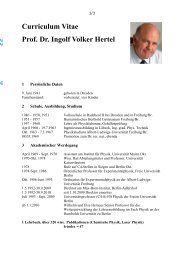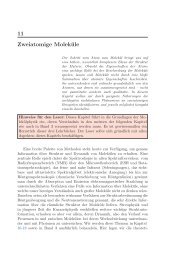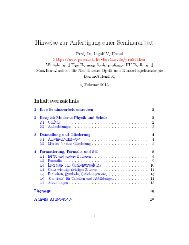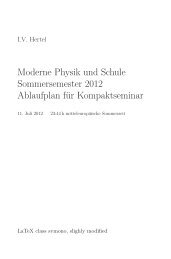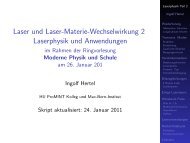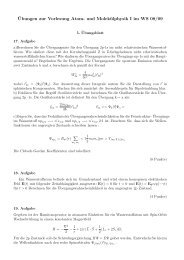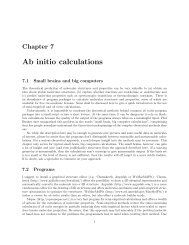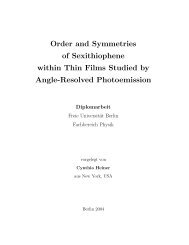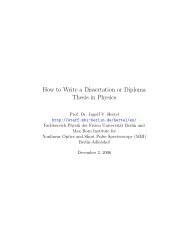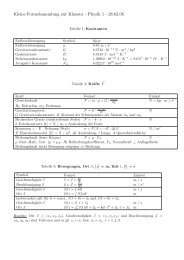Introduction into X-ray and UV Photoelectron Spectroscopy (XPS/UPS)
Introduction into X-ray and UV Photoelectron Spectroscopy (XPS/UPS)
Introduction into X-ray and UV Photoelectron Spectroscopy (XPS/UPS)
Create successful ePaper yourself
Turn your PDF publications into a flip-book with our unique Google optimized e-Paper software.
<strong>Introduction</strong> <strong>into</strong> X-<strong>ray</strong><strong>and</strong> <strong>UV</strong> <strong>Photoelectron</strong><strong>Spectroscopy</strong>(<strong>XPS</strong>/<strong>UPS</strong>)
2,0x10 61,5x10 61,0x10 65,0x10 50,0Au NVVAu 4d100 200 300 400 500 600E kin [eV]Au 4fAu 5pVB<strong>Introduction</strong> to X-<strong>ray</strong> <strong>and</strong> <strong>UV</strong><strong>Photoelectron</strong> <strong>Spectroscopy</strong> (<strong>XPS</strong>/<strong>UPS</strong>)What is <strong>XPS</strong>?How can we identify elements <strong>and</strong> compounds?What is <strong>UPS</strong>?What is a work function(Φ)?Examples of investigations using ∆Φ/<strong>UPS</strong>/<strong>XPS</strong>/HIKEAu(111)intensity [arb.u]
2,0x10 61,5x10 61,0x10 65,0x10 50,0Au NVVAu 4d100 200 300 400 500 600E kin [eV]Au 4fAu 5pVBWhat is <strong>XPS</strong>?X-<strong>ray</strong><strong>Photoelectron</strong> <strong>Spectroscopy</strong> (<strong>XPS</strong>), also known asElectron <strong>Spectroscopy</strong> for Chemical Analysis (ESCA) is awidelyusedtechniquetoinvestigatethe chemicalcomposition of surfaces.X-<strong>ray</strong> <strong>Photoelectron</strong> spectroscopy, based on the photoelectriceffect, 1,2 was developed in the mid-1960’s by Kai Siegbahn<strong>and</strong> his research group at the University of Uppsala, Sweden. 31. H. Hertz, Ann. Physik 31,983 (1887).2. A. Einstein, Ann. Physik 17,132 (1905). 1921 Nobel Prize in Physics.3. K. Siegbahn, et. al., Nova Acta Regiae Soc.Sci., Ser. IV, Vol. 20 (1967). 1981 Nobel Prize in Physics.Au(111)intensity [arb.u]
2,0x10 61,5x10 61,0x10 65,0x10 50,0Au NVVAu 4d100 200 300 400 500 600E kin [eV]Au 4fAu 5pVBAu(111)Au 4f2,0x10 6intensity [arb.u]1,5x10 61,0x10 6Au NVV5,0x10 50,0Au 5pAu 4dVB100 200 300 400 500 600E kin[eV]Au(111)intensity [arb.u]
2,0x10 61,5x10 61,0x10 65,0x10 50,0Au NVVAu 4d100 200 300 400 500 600E kin [eV]Au 4fAu 5pVBThe Photoelectric ProcessIncident X-<strong>ray</strong>Ejected <strong>Photoelectron</strong>2p2sConduction B<strong>and</strong>Valence B<strong>and</strong>FreeElectronLevelFermiLevelL2,L3L1<strong>XPS</strong> spectral lines areidentified by the shell fromwhich the electron wasejected (1s, 2s, 2p, etc.).The ejected photoelectron haskinetic energy:KE=hv-BE-ΦFollowing this process, theatom will release energy bythe emission of an AugerElectron.1sKAu(111)intensity [arb.u]
2,0x10 61,5x10 61,0x10 65,0x10 50,0Au NVVAu 4d100 200 300 400 500 600E kin [eV]Au 4fAu 5pVBAuger Relation of Core HoleEmitted Auger Electron2p2sConduction B<strong>and</strong>Valence B<strong>and</strong>FreeElectronLevelFermiLevelL2,L3L1L electron falls to fill core levelvacancy (step 1).KLL Auger electron emitted toconserve energy released instep 1.The kinetic energy of theemitted Auger electron is:KE=E(K)-E(L2) E(L2)-E(L3). E(L3).1sKAu(111)intensity [arb.u]
2,0x10 61,5x10 61,0x10 65,0x10 50,0Au NVVAu 4d100 200 300 400 500 600E kin [eV]Au 4fAu 5pVBRelative Probabilities of Relaxation ofa K Shell Core HoleProbability1.00.80.60.40.20Auger ElectronEmissionX-<strong>ray</strong> PhotonEmissionNote: The lightelements have alow cross sectionfor X-<strong>ray</strong> emission.5 10 15 20 25 30 35 40 Atomic NumberB Ne P Ca Mn Zn Br Zr Elemental SymbolAu(111)intensity [arb.u]
2,0x10 61,5x10 61,0x10 65,0x10 50,0Au NVVAu 4d100 200 300 400 500 600E kin [eV]Au 4fAu 5pVB<strong>XPS</strong> Energy ScaleThe <strong>XPS</strong> instrument measures the kineticenergy of all collected electrons. Theelectron signal includes contributions fromboth photoelectron <strong>and</strong> Auger electron lines.Au(111)intensity [arb.u]
2,0x10 61,5x10 61,0x10 65,0x10 50,0Au NVVAu 4d100 200 300 400 500 600E kin [eV]Au 4fAu 5pVB1.5x10 5Cu(111)xx0287_12,0x10 6Au(111)Au 4fintensity [arb.u.]1.0x10 55.0x10 4intensity [arb.u]1,5x10 61,0x10 6Au NVV0.03.0x10 52.5x10 5100 200 300 400 500 600 700 800 900 1000 1100 1200E kin[eV]Cu(111)2 nd order!!xx0291_15,0x10 50,0Au 4dAu 5pVBintensity [arb.u.]2.0x10 51.5x10 51.0x10 5100 200 300 400 500 600E kin[eV]5.0x10 40.0100 200 300 400 500 600E kin[eV]Au(111)intensity [arb.u]
2,0x10 61,5x10 61,0x10 65,0x10 50,0Au NVVAu 4d100 200 300 400 500 600E kin [eV]Au 4fAu 5pVBSample/Spectrometer Energy Level Diagram-Conducting Samplee -Free Electron EnergySampleKE(1s)SpectrometerKE(1s)Vacuum Level, E vFermi Level, E fhvΦ sampleΦ specBE(1s)E 1sBecause the Fermi levels of the sample <strong>and</strong> spectrometer are aligned, we only needto know the spectrometer work function, Φ spec , to calculate BE(1s).Au(111)intensity [arb.u]
2,0x10 61,5x10 61,0x10 65,0x10 50,0Au NVVAu 4d100 200 300 400 500 600E kin [eV]Au 4fAu 5pVB<strong>XPS</strong> Energy Scale - Kinetic energyKE = hv - BE - Φ specWhere: BE= Electron Binding EnergyKE= Electron Kinetic EnergyΦ spec = Spectrometer Work Function<strong>Photoelectron</strong> line energies: Dependent on photon energy.Auger electron line energies: Not Dependent on photon energy.Au(111)intensity [arb.u]
2,0x10 61,5x10 61,0x10 65,0x10 50,0Au NVVAu 4d100 200 300 400 500 600E kin [eV]Au 4fAu 5pVB<strong>XPS</strong> Energy Scale- Binding energyBE = hv - KE - Φ specWhere: BE= Electron Binding EnergyKE= Electron Kinetic EnergyΦ spec = Spectrometer Work Function<strong>Photoelectron</strong> line energies: Not Dependent on photon energy.Auger electron line energies: Dependent on photon energy.The binding energy scale was derived to make uniformcomparisons of chemical states straight forward.Au(111)intensity [arb.u]
2,0x10 61,5x10 61,0x10 65,0x10 50,0Au NVVAu 4d100 200 300 400 500 600E kin [eV]Au 4fAu 5pVBFermi Level ReferencingFree electrons (those giving rise to conductivity) findan equal potential which is constant throughout the material.Fermi-Dirac Statistics:f(E) = 1exp[(E-E f )/kT] + 1f(E)1.00.5T=0 KkT
2,0x10 61,5x10 61,0x10 65,0x10 50,0Au NVVAu 4d100 200 300 400 500 600E kin [eV]Au 4fAu 5pVBElemental ShiftsAu(111)intensity [arb.u]
2,0x10 61,5x10 61,0x10 65,0x10 50,0Au NVVAu 4d100 200 300 400 500 600E kin [eV]Au 4fAu 5pVBWhere do Binding Energy Shifts Come From?-or How Can We Identify Elements <strong>and</strong> Compounds?Pure ElementElectronElectron-electron electronrepulsionElectron-nucleus nucleusattractionFermi LevelBindingEnergyLook for changeshere by observingelectron bindingenergiesElectron-NucleusSeparationNucleusAu(111)intensity [arb.u]
2,0x10 61,5x10 61,0x10 65,0x10 50,0Au NVVAu 4d100 200 300 400 500 600E kin [eV]Au 4fAu 5pVBElemental ShiftsBinding Energy (eV)Element 2p3/2 3p ∆Fe 707 53 654Co 778 60 718Ni 853 67 786Cu 933 75 858Zn 1022 89 933Electron-nucleus attraction helps us identify theelementsAu(111)intensity [arb.u]
2,0x10 61,5x10 61,0x10 65,0x10 50,0Au NVVAu 4d100 200 300 400 500 600E kin [eV]Au 4fAu 5pVBThe Sudden ApproximationAssumes the remaining orbitals (often called the passive orbitals) arethe same in the final state as they were in the initial state (also calledthe frozen-orbital orbital approximation). Under this assumption, the <strong>XPS</strong>experiment measures the negative Hartree-Fock orbital energy:Koopman’s Binding EnergyE B,K ≅ -ε B,KActual binding energy will represent the readjustment of the N-1charges to minimize energy (relaxation):E B = EN-1f - ENiAu(111)intensity [arb.u]
2,0x10 61,5x10 61,0x10 65,0x10 50,0Au NVVAu 4d100 200 300 400 500 600E kin [eV]Au 4fAu 5pVBChemical Shifts - Electronegativity EffectsCarbon-Fluorine BondValence LevelC 2pCore LevelC 1sFluorine Electro-negativityElectron-nucleus nucleusattraction (Loss ofElectronic Screening)C 1sBindingEnergyShift to higherbinding energyAu(111)intensity [arb.u]
2,0x10 61,5x10 61,0x10 65,0x10 50,0Au NVVAu 4d100 200 300 400 500 600E kin [eV]Au 4fAu 5pVBChemical Shifts- Electronegativity EffectsFunctionalBinding EnergyGroup(eV)hydrocarbon C-H, C-C 285.0amine C-N 286.0alcohol, ether C-O-H, C-O-C 286.5Cl bound to C C-Cl 286.5F bound to C C-F 287.8carbonyl C=O 288.0Au(111)intensity [arb.u]
2,0x10 61,5x10 61,0x10 65,0x10 50,0Au NVVAu 4d100 200 300 400 500 600E kin [eV]Au 4fAu 5pVBC1s of ca. ML PFN on Au(111)intensity (arb. units)290 288 286 284 282binding energy (eV)F F F F FFFFFF F F F Fintensity (arb. units)C1s of ca. ML PFP on Au(111)1.5 eV multilayer290 288 286 284 282 280Intensity [arb.u.]1,00,80,60,40,2C1s, TTNIC1s, OTNI290 288 286 284 282 280binding energy (eV)0,0280 282 284 286 288 290 292 294 296 298Binding Energy [eV]Au(111)intensity [arb.u]
2,0x10 61,5x10 61,0x10 65,0x10 50,0Au NVVAu 4d100 200 300 400 500 600E kin [eV]Au 4fAu 5pVBElectronic Effects - Spin-Orbit CouplingC 1sAg 3dOrbital=sl=0s=+/-1/2ls=1/23d 5/23d 3/2Orbital=dl=2s=+/-1/2ls=3/2,5/26.0290288 284 280 276Binding Energy (eV)Peak Area 2 : 3378 374 370 366 362Binding Energy (eV)Cu 2p2p 3/22p 1/219.8Peak Area 1 : 2965 955 945 935 925Binding Energy (eV)Orbital=pl=1s=+/-1/2ls=1/2,3/2Au 4f3.65Peak Area 3 : 44f 5/2Orbital=fl=3s=+/-1/2ls=5/2,7/24f 7/291 87 83 79Binding Energy (eV)Au(111)intensity [arb.u]
2,0x10 61,5x10 61,0x10 65,0x10 50,0Au NVVAu 4d100 200 300 400 500 600E kin [eV]Au 4fAu 5pVBFinal State Effects - Shake-up/ Shake-offResults from energy made available in the relaxation of the final stateconfiguration (due to a loss of the screening effect of the core level electron whichunderwent photoemission).Shake-up: Relaxation energy used toexcite electrons in valence levels tobound states (monopole excitation).Shake-off: Relaxation energy used toexcite electrons in valence levels tounbound states (monopole ionization).L(2p) -> Cu(3d)Au(111)intensity [arb.u]
2,0x10 61,5x10 61,0x10 65,0x10 50,0Au NVVAu 4d100 200 300 400 500 600E kin [eV]Au 4fAu 5pVBFinal State Effects- Shake-up/ Shake-offNi MetalNi OxideAu(111)intensity [arb.u]
2,0x10 61,5x10 61,0x10 65,0x10 50,0Au NVVAu 4d100 200 300 400 500 600E kin [eV]Au 4fAu 5pVBFinal State Effects- Multiplet SplittingFollowing photoelectron emission,the remaining unpaired electronmay couple with other unpairedelectrons in the atom, resulting inan ion with several possible finalstate configurations with as manydifferent energies. This produces aline which is split asymmetrically<strong>into</strong> several components.Au(111)intensity [arb.u]
2,0x10 61,5x10 61,0x10 65,0x10 50,0Au NVVAu 4d100 200 300 400 500 600E kin [eV]Au 4fAu 5pVBElectron Scattering EffectsEnergy Loss Peakse ph + e solide* ph + e** solid<strong>Photoelectron</strong>s travelling through the solid can interact withother electrons in the material. These interactions can result inthe photoelectron exciting an electronic transition, thus losingsome of its energy (inelastic scattering).Au(111)intensity [arb.u]
2,0x10 61,5x10 61,0x10 65,0x10 50,0Au NVVAu 4d100 200 300 400 500 600E kin [eV]Au 4fAu 5pVBElectron Scattering EffectsPlasmon Loss PeakAl 2sa a a aMetalA=15.3 eVAu(111)intensity [arb.u]
2,0x10 61,5x10 61,0x10 65,0x10 50,0Au NVVAu 4d100 200 300 400 500 600E kin [eV]Au 4fAu 5pVBElectron Scattering EffectsPlasmon Loss PeakInsulatingMaterialO 1sx421 eVAu(111)intensity [arb.u]
2,0x10 61,5x10 61,0x10 65,0x10 50,0Au NVVAu 4d100 200 300 400 500 600E kin [eV]Au 4fAu 5pVBQuantitative Analysis by <strong>XPS</strong>For a Homogeneous sample:I = NσDJLλATwhere: N = atoms/cm 3σ = photoelectric cross-section, section, cm 2D = detector efficiencyJ = X-<strong>ray</strong> flux, photon/cm 2 -secL = orbital symmetry factorλ = inelastic electron mean-free path, cmA = analysis area, cm 2T = analyzer transmission efficiencyAu(111)intensity [arb.u]
2,0x10 61,5x10 61,0x10 65,0x10 50,0Au NVVAu 4d100 200 300 400 500 600E kin [eV]Au 4fAu 5pVBRelative Sensitivities of the Elements12103dRelative Sensitivity8642p4f4d21s0Li B N F Na Al P Cl K Sc V M Co Cu G As Br Rb Y Nb TcRhAg In Sb I Cs La Pr P Eu Tb Ho T Lu Ta Re Ir Au Tl BiBe C O Ne M Si S Ar Ca Ti Cr Fe Ni Zn G Se Kr Sr Zr M Ru Pd Cd SnTeXe Ba Ce Nd S G Dy Er Yb Hf W Os Pt Hg PbElemental SymbolAu(111)intensity [arb.u]
2,0x10 61,5x10 61,0x10 65,0x10 50,0Au NVVAu 4d100 200 300 400 500 600E kin [eV]Au 4fAu 5pVB3.0x10 52.5x10 5HATCN on Cu(111)xx0291_1xx0306_12.0x10 5intensity [a.u.]1.5x1051.0x10 5N1sC1s5.0x10 40.00 100 200 300 400 500 600 700E kin[eV]Au(111)intensity [arb.u]
2,0x10 61,5x10 61,0x10 65,0x10 50,0Au NVVAu 4d100 200 300 400 500 600E kin [eV]Au 4fAu 5pVB<strong>XPS</strong> of Copper-Nickel alloy12010080Cu 2pPeakAreaMct-eV/secRel.Sens.AtomicConc%Ni 2.65 4.044 49Cu 3.65 5.321 51N(E)/EThous<strong>and</strong>s6040Ni 2pCuLMM CuNi LMM CuLMM NiLMM Ni LMMLMM20Ni 3pCu 3p0-1100 -900 -700 -500 -300 -100Binding Energy (eV)Au(111)intensity [arb.u]
2,0x10 61,5x10 61,0x10 65,0x10 50,0Au NVVAu 4d100 200 300 400 500 600E kin [eV]Au 4fAu 5pVBEscape depth – mean free pathGezeigt ist die Abhängigkeit der freien Weglänge von Elektronen in Festkörpern in Abhängigkeit von derenkinetischer Energie über dem Ferminiveau. Der exakte Streumechanismus ist materialabhängig, aberinsgesamt folgt der Zusammenhang einer „universellen Kurve“, die hier als B<strong>and</strong> gezeigt ist. Diese hat einMinimum bei ca. 50 eV. Zu beachten ist die logarithmische Auftragung an beiden Achsen [87], [88].Au(111)intensity [arb.u]
2,0x10 61,5x10 61,0x10 65,0x10 50,0Au NVVAu 4d100 200 300 400 500 600E kin [eV]Au 4fAu 5pVBfrom www.lasurface.comAu(111)intensity [arb.u]
2,0x10 61,5x10 61,0x10 65,0x10 50,0Au NVVAu 4d100 200 300 400 500 600E kin [eV]Au 4fAu 5pVBsurface sensitive databulk sensitive datahν=190eVhν=630eVbulk sensitive data:the oxidic signal exceeds the metallic Ausignal;counts [a.u.]Au 2 O 3Au met(b)surface sensitive data:metallic signal more intense than oxidicsignal.(a)(c)(b)(a)90 85 80 75E B[eV]95 90 85 80E B[eV]Au 2 O 3 : Au 4f 7/2 at 85.7eV binding energy,Au (metallic) Au 4f at 84eV,chemical shift = 1.7eVAu(111)intensity [arb.u]
2,0x10 61,5x10 61,0x10 65,0x10 50,0Au NVVAu 4d100 200 300 400 500 600E kin [eV]Au 4fAu 5pVBHIGH KINETIC ENERGY PHOTOELECTRON SPECTROSCOPY(HIKE) on Thin Film Solar CellsIntensity / a.u.9000eV8000eV7000eV6500eV6000eV5500eV5000eV4000eV3000eVIntensity / a.u.Se2p1500eV 1480 1460 1440 1420Binding Energy / eVGlass + MoSe2pGa2pZn(O,S) - 15 nm buffer layerCu(In,Ga)Se 2 (CIGS)Cu2pIntensity / a. u.Cu2p920 940 960eVBinding Energy / eVAbove approximately 5 keVexcitation energy thesubstrate becomes visible!2500eV 2000 1500 1000Binding Energy / eVDepth profiling ofthe device ispossible!Johansson, Platzer-Björkman, Gorgoi, et al, Rev. Sci. Instrum. 78 (2007) 1.intensity [arb.u]Au(111)
2,0x10 61,5x10 61,0x10 65,0x10 50,0Au NVVAu 4d100 200 300 400 500 600E kin [eV]Au 4fAu 5pVBCs 2 Te photocathodes for electron accelerators: new,contaminated, used, oxidisedcompositioncontaminationchemical analysisIntensity [arb.units]survey @ 900eV photon energy5x10 4Cs3 3dsample 1, new4x10 43x10 42x10 41x10 4Te 3dO1sMo 3dAugersCs <strong>and</strong> Tesignalsnewoxidisedcounts / 10016012080403d5/2 2-3d5/2 03d3/2 2-3d5/2 6+measurement 900 eVbackground3d3/2 03d3/2 6+plasmon peakIntensity [arb.units]00 200 400 600 800 1000Ekin[eV]survey @ 900eV photon energy4.0x103.5x10Cs3 3d sample 3, used DESY3.0x1042.5x1042.0x1041.5x1041.0x1045.0x103F1sTe 3dAugersC1sCs <strong>and</strong> Tesignals0.00 200 400 600 800 1000Ekin[eV]TeflonContaminatedusedexposedto badvacuumcounts0565 570 575 580 585 590 595E b(eV)500045004000350030002500200015001000#90.1 (fresh)#92.1 (used)photoemissiveb<strong>and</strong>valence b<strong>and</strong>score likeCs 5p50000 2 4 6 8 10 12 14 16 18 20E b (eV)Au(111)intensity [arb.u]
Counts2,0x10 61,5x10 61,0x10 65,0x10 50,0Au NVVAu 4d100 200 300 400 500 600E kin [eV]Au 4fAu 5pVBSecondary electron cutoff (SECO)HOMO or E FE kin,SECOEkin,HOMOEkin,EFE kinAu(111)intensity [arb.u]
Counts2,0x10 61,5x10 61,0x10 65,0x10 50,0Au NVVAu 4d100 200 300 400 500 600E kin [eV]Au 4fAu 5pVBSecondary electron cutoff (SECO)valence states<strong>UPS</strong>: valence orbitalsinterface statesHOMO or E FEE kinionization energy = hν – (E kin,HOMO – E kin,SECO )work function = hν – (E kin,EF – E kin,SECO )EE kin,HOMOkin,EFintensity [arb.u.]2.4x10 52.2x10 52.0x10 51.8x10 51.6x10 51.4x10 51.2x10 51.0x10 58.0x10 4C60 on CH8000Z0115_1Z0117_1Z0119_1Z0120_1Z0121_1Z0131_1Z0132_1Z0133_1Z0136_1E kin,SECO20 25 30 35 406.0x10 4hole injection barrier = E kin,EF – E kin,HOMO4.0x10 42.0x10 40.0E kin[eV]Au(111)intensity [arb.u]
2,0x10 61,5x10 61,0x10 65,0x10 50,0Au NVVAu 4d100 200 300 400 500 600E kin [eV]Au 4fAu 5pVBWorkfunctionFreeElectronVacuumLevel, E vhvFermiLevel, E fΦ sampleE 1sBindingenergy„Push-back“ effectCharge transferCovalent bond formationPermanent dipolesIshii, Sugiyama, Ito, Seki, Adv. Mater. 11, 605 (1999); Kahn, Koch, Gao, J. Poly. Sci. B 41, 2529-2548 (2003)intensity [arb.u]Au(111)
2,0x10 61,5x10 61,0x10 65,0x10 50,0Au NVVAu 4d100 200 300 400 500 600E kin [eV]Au 4fAu 5pVBIntensity [arb.units]1,00,80,60,40,20,0Cu(111)Ag(111)Au(111)14 12 10 8 6 4 2 0E binding[eV]intensity (arb. units)θ e= 45°(1)(2)3 2 1 0binding energy (eV)MT(Å)02481650110intensity (arb. units)MT(Å)∆ PEN024816501109 10 11kinetic energy (eV)energy level diagrams ofPEN/Au(111)E vacφ Au = 5.50∆ vac,PEN = 0.95φ PEN= 4.550.60 0.90E F(1) (2)Au(111)intensity [arb.u]
2,0x10 61,5x10 61,0x10 65,0x10 50,0Au NVVAu 4d100 200 300 400 500 600E kin [eV]Au 4fAu 5pVBAu(111)intensity [arb.u]
k2,0x10 61,5x10 61,0x10 65,0x10 50,0Au NVVAu 4d100 200 300 400 500 600E kin [eV]Au 4fAu 5pVBREMINDERey c sStrommessunge -Photoemission providesinformation on:e e e e e e e e e ee e e e e ee eeeee e eesV l zSchale:MLE- Chemical composition- Chemical state/reaction- Electronic state- Interfaces/interface reactions- Quantitative analysis- Depth profilingeeKH.-Ch. Mertins / Ch. Jung / M. MastMai 2004photoeffekt.dsfAu(111)intensity [arb.u]
Thank you!




